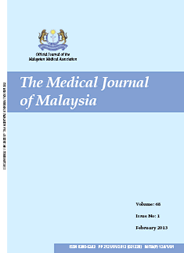MJM, Vol 70 Supplement 1 September 2015
Comparative risk assessment of modifiable risk
factors for mortality for cardiovascular diseases of atherosclerotic origin in
Malaysia
*Kuantan District Health Office, Pahang **UKM Medical Faculty, Kuala Lumpur, ***Institute of Public Health Malaysia, Kuala Lumpur
ABSTRACT
Introduction: Cardiovascular disease (CVD) of atherosclerotic origin is the leading cause of deaths in Malaysia. Comparative Risk Assessment (CRA) estimates number of mortality that would be prevented if current distributions of risk factor exposures were changed to hypothetical optimal distributions. The aim of this research was to estimate the 5-years CVD mortality effects of hypothetical changes in seven modifiable risk factors in Malaysia.
Methods: Using the WHO CRA formula, we estimated the 5-years CVD mortality effects of hypothetical changes using data from the NHMS 2006 and the mortality statistics focusing on Ischaemic Heart Disease (IHD) and stroke. The etiological effects of risk factors were obtained from recent published systematic reviews and meta-analysis.
Results: High SBP and physical inactivity were responsible for an estimated of 43,600 (95% CI 43,200-43,900) and 42,400 (95% CI 42,100-42,800) 5-years CVDs mortality respectively. Each lead to one in four CVDs deaths. Hypercholesterolaemia (21,500; 95%CI 21,300-21,800) and smoking (21,400; 95% CI 21,100-21,600) were each responsible for one in seven CVDs deaths while high FBS (8,600; 95% CI 8,400-8,800) lead to one in 17 CVDs deaths, high BMI (5,100; 95% CI 5000-5300) lead to one in 30 CVDs deaths and alcohol intake (3200; 95% CI 3100-3300) lead to one in 50 CVDs deaths. Analysis by gender, ethnicity, stratum and states showed high SBP and physical inactivity were the most important. However, among those aged 30-59 years old, smoking was at the top ranking while for the older group physical inactivity was the leading risk factor.
Conclusion: High SBP and physical inactivity were responsible for the largest number of CVD-mortality in Malaysia. However, among those aged 30-59 years old, smoking was the upmost risk factor for CVD deaths. Interventions to curb CVDs mortality should target the most dominant modifiable risk factors for each group at risk.
Keywords: Comparative Risk Assessment, Ischaemic Heart Disease, stroke, mortality attributable risk factor.
